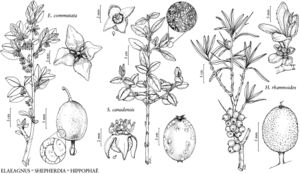Elaeagnus
Sp. Pl. 1: 121. 1753.
| Taxon | Illustrator ⠉ | |
|---|---|---|
 | Elaeagnus commutata Shepherdia canadensis Hippophaë rhamnoides |
Shrubs or trees, polygamous, armed or unarmed, clonal or not. Stems densely pubescent with scales and stellate hairs or glabrate. Leaves deciduous or evergreen, alternate; petiolate; blade ovate, ovate-oblong, elliptic, lanceolate, lanceolate-linear, or cuneate, base attenuate or blunt, apex rounded, surfaces with silvery scales and stellate hairs (scales sometimes brown abaxially in E. commutata and E. multiflora, sometimes glabrous adaxially in E. multiflora). Inflorescences umbellate, or flowers paired or solitary, appearing after leaves. Pedicels present. Flowers bisexual; hypanthium conspicuous; calyx lobes 5; nectary disc conspicuous or inconspicuous; stamens 4, alternate with calyx lobes; style linear, stigmatic on 1 side. Fruits drupelike, silver, pale green, red, reddish-brown, or pink, fleshy or dry. Seeds striate. x = 6, 14.
Distribution
North America, Eurasia, Australia
Discussion
Species ca. 45 (5 in the flora).
The flowers of Elaeagnus are strongly sweet-scented with a fragrance that most people find pleasant; the fruits are generally edible and attractive to birds. Some Eurasian species have been introduced into the horticulture trade and are now naturalized in North America (M. A. Dirr 2009). Some of these species have the potential to hybridize with native species; E. angustifolia, E. pungens, and E. umbellata have become noxious weeds. New introductions should be carefully considered and monitored.
Selected References
None.
Lower Taxa
Key
| 1 | Shrubs or trees 2–10(–12) m; leaves deciduous, blade surfaces densely silver or silver-green, (sometimes less densely so or with scattered, brown scales abaxially). | > 2 |
| 2 | Leaf blades ovate-oblong or elliptic (lengths 2 times widths); nectary discs incon- spicuous; stems unarmed, scales gray in age. | Elaeagnus commutata |
| 2 | Leaf blades lanceolate-linear to narrowly elliptic (lengths 3–8 times widths); nectary discs conspicuous; stems usually armed, with thornlike lateral branches, scales reddish brown in age. | Elaeagnus angustifolia |
| 1 | Shrubs or trees 1–5 m; leaves deciduous or evergreen, blade surfaces silvery or silver-green abaxially, silver-green or green adaxially. | > 3 |
| 3 | Stems armed; leaves evergreen, blades leathery, margins wavy, surfaces with silver scales, more densely hairy and silvery-green abaxially, glabrous and lustrous dark green or dull silver-green adaxially; petioles woody. | Elaeagnus pungens |
| 3 | Stems usually unarmed (young ones thornlike in E. umbellata); leaves deciduous, blades not leathery, margins entire or ± wavy, surfaces silvery abaxially (sometimes with scattered, brown scales), green or dark green and sparsely pubescent or glabrous adaxially; petioles not woody. | > 4 |
| 4 | Flowers solitary or paired, hypanthium broadly flared, calyx lobes with brown scales outside; leaf blades 1–2.5(–5) cm, broadly lanceolate or cuneate. | Elaeagnus multiflora |
| 4 | Flowers densely clustered, hypanthium narrowly funnelform, calyx lobes with silver scales outside; leaf blades (2–)3–8(–10) cm, elliptic or ovate. | Elaeagnus umbellata |